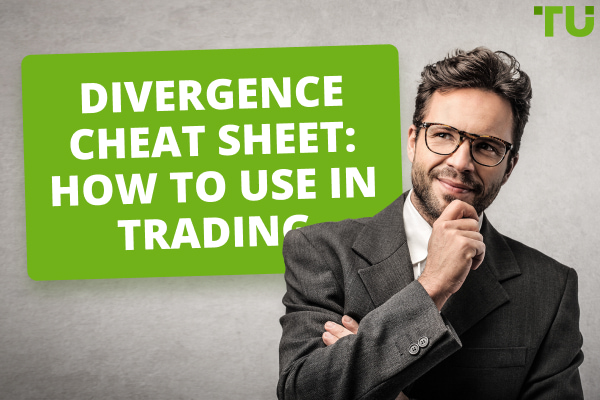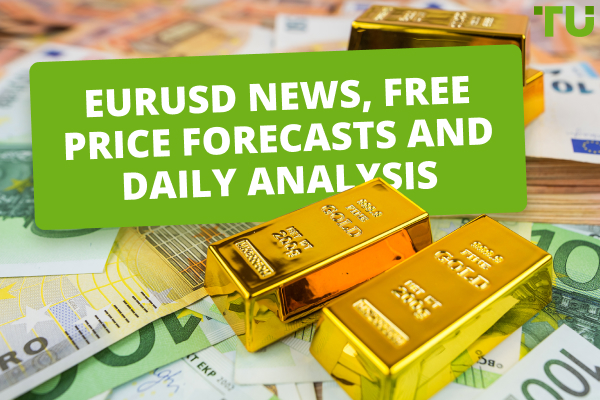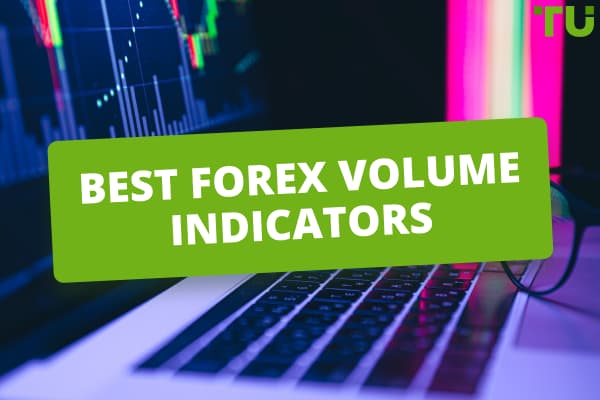How Does High-Frequency Trading Work
Top 4 HFT trading strategies are:
Statistical arbitrage - exploiting price discrepancies between currency pairs using statistical models.
Market making - providing liquidity and profiting from bid-ask spreads through continuous order placement.
News-based trading - reacting quickly to market-moving events and news releases to capitalize on short-term price movements.
Scalping - executing rapid trades to profit from small price changes within seconds or minutes.
High-frequency trading (HFT) can be intriguing due to its innovative and dynamic nature, presenting traders with unique opportunities for swift and precise execution in the fast-paced financial markets. The appeal lies in its ability to capitalize on tiny price fluctuations within milliseconds, enabling traders to make numerous trades in short timeframes, potentially yielding significant profits. The application of sophisticated algorithms and advanced technology allows for efficient data analysis, strategy formulation, and rapid order execution, giving traders a competitive edge.
This article serves as a comprehensive guide to understanding top high-frequency trading (HFT) strategies to know. Discover the typical trading approaches and the required investments for their implementation
Do you want to start trading Forex? Open an account on Roboforex!-
What strategies do HFT use?
HFT (High-Frequency Trading) uses a variety of strategies, including statistical arbitrage, market making, news-based trading and scalping. These strategies involve rapid and automated trading to capitalize on short-term price movements, market inefficiencies, and macroeconomic events.
-
Is high frequency trading legal?
Yes, high-frequency trading is legal in most jurisdictions, including Europe and the USA. However, it is subject to strict regulatory oversight to ensure fair and transparent markets. HFT firms must comply with regulations set by financial authorities, which may include rules on market access, algorithmic trading, risk controls, and prevention of market manipulation.
-
How do I become a HFT trader?
Becoming a High-Frequency Trader requires a combination of expertise and resources. Start by gaining a deep understanding of financial markets, trading strategies, and quantitative analysis. Develop strong programming skills in languages such as C++, Java, or Python. Acquire sufficient capital and invest in high-performance trading infrastructure. Lastly, create and thoroughly test your HFT trading strategy before venturing into the live markets.
-
How much do HFT traders make?
The earnings of HFT traders can vary significantly depending on factors such as trading strategies, market conditions, and the level of expertise. Successful HFT firms, like Jim Simons' Medallion Fund, have achieved impressive compound annual growth rates. However, HFT trading is a highly competitive field, and not all traders achieve extraordinary profits. Skilled HFT traders with successful strategies may earn substantial profits, but it's essential to manage risk carefully and understand that trading results can fluctuate over time.
What is high-frequency trading (HFT)?
High-frequency trading (HFT) is a form of financial trading characterized by an extremely high volume of trades executed within milliseconds or microseconds. Traders engage in HFT to take advantage of small price discrepancies in the market. Positions are held for very short amounts of time, often just fractions of a second, allowing traders to profit from rapid market movements. The main features of HFT include the use of sophisticated algorithms, co-location proximity to exchanges for reduced latency, and access to high-speed data feeds.
Traders are recommended to read: "The Quants: How a New Breed of Math Whizzes Conquered Wall Street and Nearly Destroyed It" as it offers a revealing account of the ascent of quantitative trading and its influence on financial markets. The book sheds light on the innovative strategies employed by genius mathematically-driven traders and their impact on the global economy, leading up to the near-collapse of Wall Street during the financial crisis. This compelling narrative provides valuable insights into the power and risks associated with quantitative approaches in trading.
Top 4 HFT strategies
Let’s review some popular HFT strategy in more detail, along with the requirements for traders to effectively implement them:
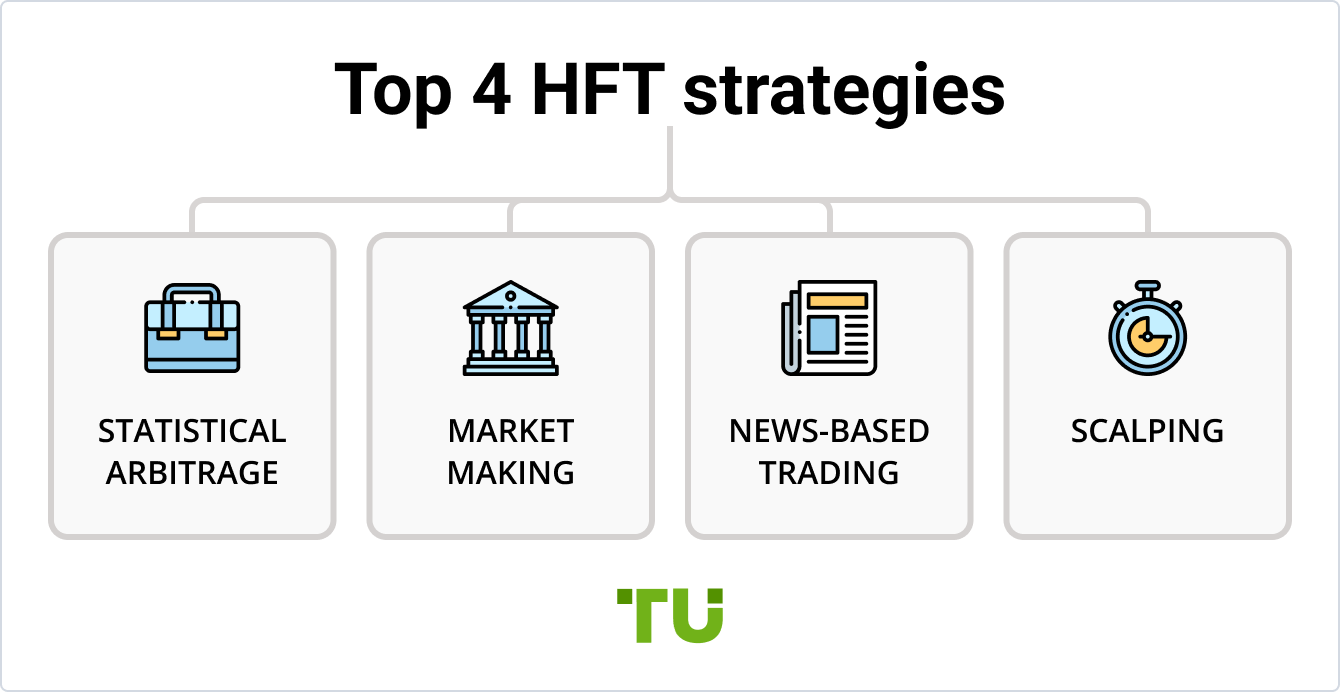
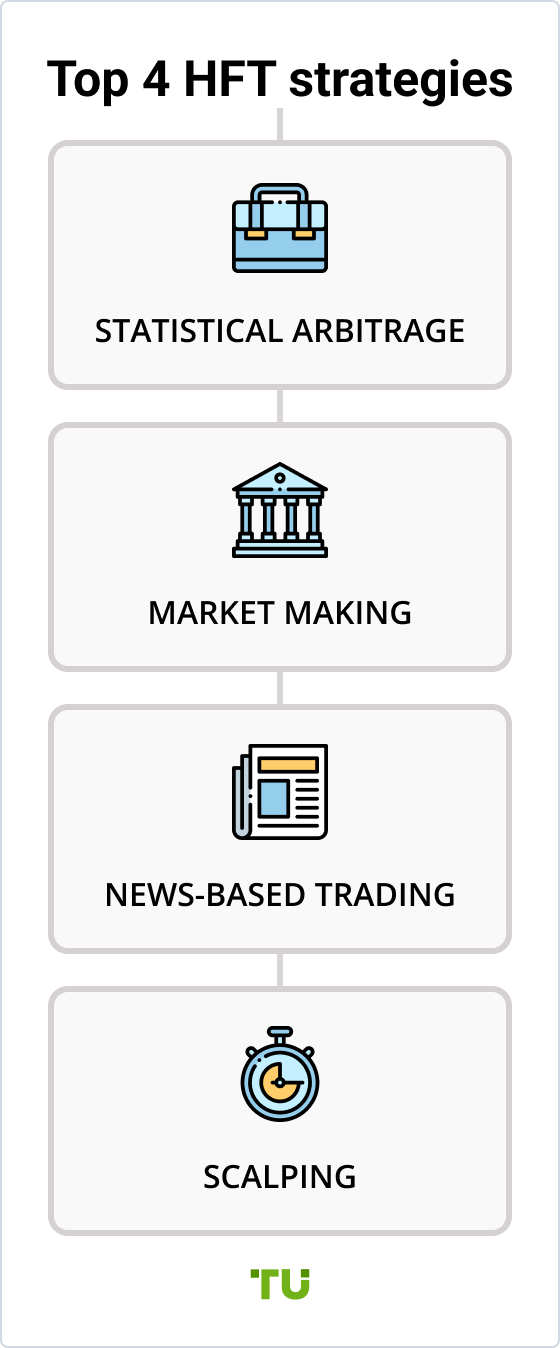
Statistical arbitrage
Statistical arbitrage involves exploiting temporary price discrepancies between related currency pairs using statistical models and historical data analysis. To implement this strategy traders need access to historical price data of the currency pairs they intend to trade and the ability to process large datasets efficiently.
Requirements. Advanced statistical modeling skills are crucial for developing algorithms that can identify and act on pricing anomalies.
Hardware: High-speed execution is vital for capitalizing on fleeting arbitrage opportunities, necessitating low latency trading infrastructure.
Investments: from $100,000 to $1,000,000+
Market making
Market makers provide liquidity to the Forex market by continuously placing bid and ask orders, profiting from the spread between these prices. Successful market making requires a thorough comprehension of market behavior and order flow.
Requirements. Traders must design algorithms that can manage order books, adjust bid-ask quotes, and handle rapid order processing. Market making involves maintaining positions on both sides of the market, necessitating adequate capital to cover potential imbalances.
Investments: from $500,000 to $5,000,000+
3 News-based trading
This strategy involves reacting swiftly to market-moving events and news releases to capitalize on short-term price movements triggered by the information.
Requirements. Traders need access to high-quality, low-latency data feeds to receive news releases and economic indicators as quickly as possible. Natural language processing and sentiment analysis tools can be valuable for extracting meaningful insights from news data.
Hardware. Rapid execution is critical, so traders must have automated systems that can process and act on news information in real-time.
Investments: from $100,000 to $1,000,000+
Scalping
Scalping is considered a potentially cheaper way to adopt HFT due to its lower technology and infrastructure requirements compared to other HFT strategies. This strategy entails executing a large number of rapid trades to profit from small price changes within seconds or minutes.
Requirements. Traders need high-performance trading platforms and low-latency connections to execute trades swiftly. Developing algorithms that can quickly identify and act on short-term price movements is crucial.
Investments: $10,000 to $100,000+
Overall, successful implementation of Аorex HFT strategies demands a combination of advanced technological infrastructure, data analysis skills, market knowledge, and risk management expertise. Additionally, substantial investment in technology and market access is typically required to compete effectively in the fast-paced and competitive world of high-frequency trading.
Advantages and Disadvantages of HFT
HFT is right for you if:
•you prioritize quick order execution to capitalize on rapid market movements and take advantage of short-term price discrepancies.
•you appreciate the role of HFT in contributing to market liquidity, leading to tighter bid-ask spreads and potentially lower transaction costs.
•you are involved in arbitrage strategies that leverage HFT capabilities to identify and exploit price differences across various markets.
•you believe in the benefits of HFT in enhancing market efficiency by quickly incorporating new information and ensuring that asset prices reflect the most recent data.
•you are looking for lower trading costs, as HFT can contribute to reduced transaction costs through tighter spreads and increased liquidity.
HFT is not right for you if:
•you are concerned about the potential contribution of HFT to market instability, especially during times of rapid market movements.
•you believe that HFT firms with advanced technology may have an unfair advantage over individual traders or slower institutional investors.
•you have concerns about certain HFT strategies potentially leading to market manipulation, such as "quote stuffing" or creating artificial demand.
•you value transparency in market activities and find HFT strategies too complex or difficult to understand.
•you are not comfortable with market fragmentation caused by HFT, where orders are executed across multiple trading venues.
•you are risk-averse and concerned about the technical glitches or errors that can occur in HFT, potentially leading to financial losses or market disruptions.
•maintaining investor confidence in the fairness and integrity of financial markets is a priority for you, and you believe that the presence of HFT may negatively impact this confidence.
Different types of HFT algorithms
Various types of HFT algorithms are used in Forex trading, including:
Statistical. These algorithms use statistical models to identify patterns and trends in market data, helping traders make informed trading decisions.
Market Inefficiency. This algorithm seeks to exploit pricing discrepancies and inefficiencies in the markets, utilizing high-frequency trading techniques to capitalize on temporary mispricings.
Auto-hedging algorithms are employed to manage risk by automatically executing offsetting trades to protect against adverse price movements.
Execution strategies. These algorithms focus on optimizing the execution of trades to achieve the best possible prices and reduce transaction costs.
Direct market access algorithms enable traders to directly access exchange order books, facilitating faster order execution and reduced latency.
Top 3 HFX trading brokers 2024
IC Markets
IC Markets is a leading online forex trading broker offering a comprehensive suite of trading tools and resources to meet the needs of all types of traders. With its award-winning MetaTrader 4 platform, IC Markets offers fast execution speeds with no dealing desk intervention to ensure that trades are executed at the best possible prices.
IC Markets features a bot trading platform known as CTtader Automate. It is an automated trading software that is used with cTrader. Using the C# language and the source code editor of cTrader Automate, you can develop algorithmic trading systems and customized technical indicators for technical analysis. Within cTrader, custom indicators will appear alongside built-in indicators.
On currency pairs, they execute trades in around 35 milliseconds on average. EUR/USD spreads average 0.1 pips on raw spread accounts, with only $3.50 in commissions payable per lot.
RoboForex
RoboForex is an international online broker that offers its clients access to a wide range of financial assets. Their award-winning trading platform, R Trader Pro, provides direct market access with superior execution speeds and no dealing desk intervention to ensure that trades are executed at the best possible prices.
They also offer automated trading through R StocksTrader, which allows you to set up a trading robot to test trading strategies. The platform offers order execution speeds of 0.1 seconds, which is ideal for HFX trading. The average spread for the EUR/USD spread on the raw account starts at 0.0 pips. RoboForex offers a free VPS server for strong security and less slippage.
Interactive Brokers
Interactive Brokers is one of the leading online brokers offering a comprehensive suite of trading tools and resources to meet the needs of all types of traders. With their award-winning Trader Workstation platform, Interactive Brokers provides access to global markets with lightning fast execution speeds and no dealing desk intervention to ensure that trades are executed at the best possible prices. In addition, they offer an array of tradable instruments including foreign exchange (FX) pairs, indices, commodities as well as CFDs on stocks, cryptocurrencies and ETFs.
By using IB's high-speed order routing capability and broad market depth, you can create an automated rule-based trading system. With the API, you can trade all products supported by TWS, including stocks, options, futures, forex, and bonds. The broker has fast trade execution speed. There is only a small commission of $2 per lot payable per side on the raw spread account. The EUR/USD spread averages 0.6 pips. At an affordable price, Interactive Brokers offers rock solid, low latency trading servers in Amsterdam, NL.
Is HFT good for me?
HFT can be a suitable option for certain individuals and institutions with specific advantages. If you possess strong mathematical and trading skills, have a dedicated team of skilled data analysts, and sufficient capital to invest in the necessary equipment and data feeds, HFT may present an opportunity to capitalize on rapid market movements and execute numerous trades at high speeds.
However, it's important to note that HFT is an extremely competitive and complex field, typically dominated by large financial institutions and hedge funds with significant resources and infrastructure.
How to start high-frequency trading
Starting HFT involves a systematic approach to ensure success in the fast-paced and competitive market. Here is a step-by-step algorithm to guide you:
Learn as much as you can. Begin by thoroughly studying Forex, stock and crypto markets, trading strategies, and the principles of high-frequency trading. Familiarize yourself with market mechanics, order types, and the impact of high-frequency strategies on execution.
HFT strategy is the key. Create a well-defined and tested high-frequency trading strategy. It should be based on statistical analysis, technical indicators, or market patterns, designed to capitalize on rapid price movements.
Broker. Look for a HFT broker that offers maximum trading volume and minimal trading costs, as these factors significantly impact HFT profitability. Some brokers offer essential discounts or rebates specifically designed for high-frequency traders, which can help reduce transaction costs and improve overall trading performance. However, be aware that not all brokers are HFT-friendly, and some may impose restrictions or limitations on high-frequency trading activity. Therefore, it is crucial to thoroughly research and choose a broker that supports and facilitates active trading strategies to ensure a smooth and profitable HFT experience.
Acquire trading infrastructure. Invest in powerful and low-latency trading infrastructure. This includes high-performance computers, reliable internet connections, and co-location services near exchange servers for reduced latency.
Start small and scale up. Begin with a small trading capital and gradually increase your position sizes as you gain experience and confidence in your strategy.
Monitor and adapt. Continuously monitor your trading performance and adapt your strategy as market conditions change. Analyze trading results, identify strengths, and improve weaknesses in your approach.
Stay Informed. Keep yourself updated with market news, economic events, and any changes in regulations that may impact your trading strategy.
Programming languages
When comparing programming languages for high-frequency trading (HFT), C++, Java, and Python stand out as popular choices with distinct strengths and trade-offs.
C++ is known for its exceptional performance and low-level memory management, making it a preferred language for HFT. Its ability to execute highly optimized code allows for lightning-fast execution, crucial for high-frequency trading strategies. C++ provides direct hardware access and minimal overhead, which reduces latency and enhances speed. However, C++ can be more challenging to learn and develop in compared to other languages due to its complexity and manual memory management.
Java is lauded for its portability and ease of use, making it attractive for HFT applications that require platform independence. It offers a balance between performance and ease of development, allowing traders to write code more quickly. Java's Just-In-Time (JIT) compilation can sometimes introduce slight latency compared to C++. Nevertheless, it still provides competitive speed and is well-suited for large-scale, distributed systems.
Python is renowned for its simplicity and rapid prototyping capabilities, making it a popular choice for research and data analysis in finance. While Python offers a shorter development cycle, it generally lags behind C++ and Java in terms of raw execution speed due to its interpreted nature. However, Python's ecosystem, extensive libraries, and ease of integration with other technologies make it valuable for certain aspects of HFT, such as data analysis and strategy development.
The choice of programming language for HFT depends on the specific needs and priorities of traders and their trading strategies. Many HFT firms may even use a combination of these languages for different components of their systems to leverage the strengths of each language effectively.
Is HFT trading regulated?
Yes, high-frequency trading (HFT) is regulated in many countries and jurisdictions. Regulatory authorities recognize the impact of HFT on financial markets and have implemented measures to ensure fairness, transparency, and stability.
The regulations may vary depending on the country, but some common areas of focus include market access and membership requirements, algorithmic trading rules, prevention of market manipulation and abuse, market surveillance, co-location rules, and reporting requirements. Complying with these regulations is crucial for HFT firms to avoid penalties and maintain their reputation in the financial markets. As the landscape of HFT and financial markets continues to evolve, regulators are likely to adapt and refine their oversight to address emerging challenges and ensure market integrity.
Is HFT legal in the USA?
Similarly, high-frequency trading is legitimate in the United States. HFT is regulated by the U.S. Securities and Exchange Commission (SEC) and the Commodity Futures Trading Commission (CFTC). These regulatory bodies have established rules to govern HFT activities, such as market access, algorithmic trading, and risk controls, to maintain market stability and prevent manipulation. As long as HFT firms abide by the established regulations, they can legally operate in the U.S. financial markets.
Is HFT legal in Europe?
Yes, high-frequency trading (HFT) is considered legitimate in Europe. HFT practices are subject to regulatory oversight by various financial authorities to ensure fair and transparent markets. While regulations may vary across European countries, authorities impose rules to prevent market abuse, ensure investor protection, and maintain market integrity.
Who is the best HFT trader in the world?
Jim Simons is a prominent figure in the financial world. Trader is known for his success as a quantitative trader and hedge fund manager. He is the founder of Renaissance Technologies, a highly successful quantitative investment firm. Simons is a former mathematics professor and codebreaker during the Cold War, and he applied his mathematical expertise to develop groundbreaking trading strategies.
Under his leadership, Renaissance Technologies' flagship fund, Medallion Fund, achieved outstanding returns over the years, earning Simons a reputation as one of the most successful and influential HFT traders in the world. The reported compound annual growth rate (CAGR) of 62% between 1988 and 2021 is remarkable, showcasing the fund's ability to deliver outstanding returns to its investors. It is important to note that this performance includes the impact of significant fund management fees, indicating that even after deducting these fees, the fund still achieved an impressive 37% annualized rate of return.
In the “Quants” you can find quite more info about other prominent names in the HFT world.
Team that worked on the article
Andrey Mastykin is an experienced author, editor, and content strategist who has been with Traders Union since 2020. As an editor, he is meticulous about fact-checking and ensuring the accuracy of all information published on the Traders Union platform. Andrey focuses on educating readers about the potential rewards and risks involved in trading financial markets.
He firmly believes that passive investing is a more suitable strategy for most individuals. Andrey's conservative approach and focus on risk management resonate with many readers, making him a trusted source of financial information.
Dr. BJ Johnson is a PhD in English Language and an editor with over 15 years of experience. He earned his degree in English Language in the U.S and the UK. In 2020, Dr. Johnson joined the Traders Union team. Since then, he has created over 100 exclusive articles and edited over 300 articles of other authors.
Mirjan Hipolito is a journalist and news editor at Traders Union. She is an expert crypto writer with five years of experience in the financial markets. Her specialties are daily market news, price predictions, and Initial Coin Offerings (ICO).







